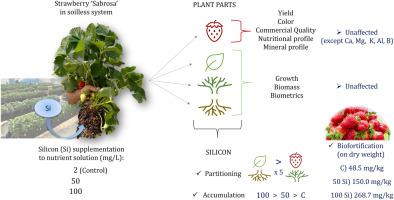Silicon partitioning and accumulation in agronomic biofortification of strawberry (Fragaria × ananassa) cv. Sabrosa grown in soilless system
IF 4.2
2区 农林科学
Q1 HORTICULTURE
引用次数: 0
Abstract
Strawberry (Fragaria × ananassa Duch.) is a globally significant horticultural crop, appreciated for the nutritional profile of its fruits. This study investigated uptake, accumulation, and effects of silicon (Si) supplementation through nutrient solutions (50 and 100 mg L⁻¹ K₂SiO₃) in Sabrosa (known by the trade name ‘Candonga’) strawberries grown in a soilless system. Si was taken up and translocated dose-dependently, with the highest accumulation in roots and leaves and lower levels in fruits and stems. Si supplementation significantly increased fruit Si content, with a three-fold and five-fold increase at 50 mg L⁻¹ and 100 mg L⁻¹ doses, respectively, compared to the control. Despite the significant Si accumulation, no dose influenced growth, yield, or key fruit quality parameters, including firmness, dry matter, total soluble solids, and nutraceutical profile. Although mineral interactions were observed, with reductions in Ca, Mg, and K content in plant tissues and increased B in fruits and Al in roots only at 50 mg L⁻¹, this did not affect fruit nutritional or organoleptic qualities. Given the increased electrical conductivity associated with higher Si doses, 50 mg L⁻¹ is recommended as an effective biofortification dose. The lack of response suggests that strawberry is able to tolerate considerable Si enrichment without alterations to its agronomic performance or fruit biochemical traits. These findings provide novel insights into the potential for Si biofortification of strawberries, highlighting a unique opportunity to enrich fruits with Si for human health benefits without compromising crop productivity or quality.

草莓(Fragaria × ananassa)农艺强化中硅的分配与积累Sabrosa种植在无土系统中
草莓(Fragaria × ananassa Duch.)是一种全球重要的园艺作物,因其果实的营养成分而受到赞赏。这项研究调查了在无土系统中种植的Sabrosa(商品名‘ Candonga ’)草莓中通过营养液(50和100 mg L -¹K₂SiO₃)补充硅(Si)的吸收、积累和影响。硅的吸收和转运是剂量依赖性的,根和叶的积累量最高,果实和茎的积累量较低。补充Si显著增加了水果中Si的含量,与对照组相比,50 mg L -⁻¹和100 mg L -⁻¹的剂量分别增加了3倍和5倍。尽管硅积累显著,但没有剂量影响生长、产量或关键果实品质参数,包括硬度、干物质、总可溶性固形物和营养成分。虽然观察到矿物质的相互作用,仅在50 Mg L - 1时,植物组织中的Ca, Mg和K含量减少,果实中的B和根中的Al含量增加,但这并不影响果实的营养或感官品质。考虑到高剂量的硅会增加导电率,50mg L - 1被推荐为有效的生物强化剂量。缺乏响应表明草莓能够耐受大量的硅富集而不改变其农艺性能或果实生化性状。这些发现为草莓的硅生物强化潜力提供了新的见解,强调了在不影响作物生产力或质量的情况下用硅丰富水果对人类健康有益的独特机会。
本文章由计算机程序翻译,如有差异,请以英文原文为准。
求助全文
约1分钟内获得全文
求助全文
来源期刊

Scientia Horticulturae
农林科学-园艺
CiteScore
8.60
自引率
4.70%
发文量
796
审稿时长
47 days
期刊介绍:
Scientia Horticulturae is an international journal publishing research related to horticultural crops. Articles in the journal deal with open or protected production of vegetables, fruits, edible fungi and ornamentals under temperate, subtropical and tropical conditions. Papers in related areas (biochemistry, micropropagation, soil science, plant breeding, plant physiology, phytopathology, etc.) are considered, if they contain information of direct significance to horticulture. Papers on the technical aspects of horticulture (engineering, crop processing, storage, transport etc.) are accepted for publication only if they relate directly to the living product. In the case of plantation crops, those yielding a product that may be used fresh (e.g. tropical vegetables, citrus, bananas, and other fruits) will be considered, while those papers describing the processing of the product (e.g. rubber, tobacco, and quinine) will not. The scope of the journal includes all horticultural crops but does not include speciality crops such as, medicinal crops or forestry crops, such as bamboo. Basic molecular studies without any direct application in horticulture will not be considered for this journal.
 求助内容:
求助内容: 应助结果提醒方式:
应助结果提醒方式:


